Health is wealth! If we had a penny for every time that phrase is passed around, we wouldn’t have to worry about money at all. But cliched as it may be, there’s no denying the truth which this phrase stands for.
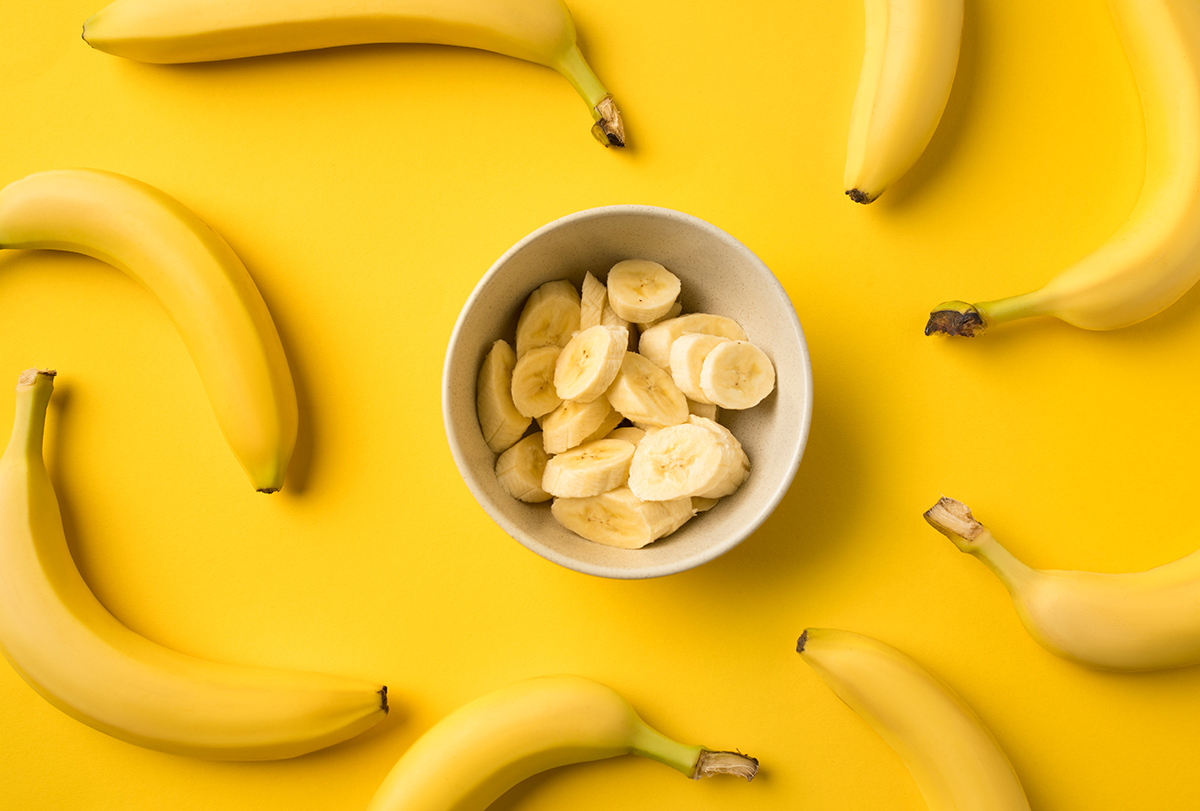
You cannot neglect your health and nutrition in order to save money. However, people are forced to make budget cuts during a financial crunch that keeps them from buying all the healthy foods they want.
This article will list some easily available food items that cost next to nothing but can give you a heavy dose of nutrition.
Cheap and Healthy Foods That You Can Add to Your Diet
Here are 10 healthy foods to eat on a tight budget.
1. Eat bananas
Even when you are broke, bananas are one fruit that you can consume daily without any guilt or concern.
This inexpensive fruit is one of the best sources of potassium, an electrolyte that helps maintain a proper water balance in the body along with effectively regulating blood pressure.
This mineral also contributes to building your muscle strength, enhanced nerve and kidney functioning, and better digestion.
A 2014 study published in the journal Stroke reports that potassium intake is associated with a lower risk of strokes, including ischemic strokes, as well as all-cause mortality in older women, particularly those who are not hypertensive. (1)
Along with potassium, bananas are also a good source of antioxidants such as vitamin A, C, and E, all of which act as free-radical scavengers and help improve your overall health. (2)
Bananas are particularly helpful to athletic performance and are a gift for those who indulge in regular exercise. This claim was supported by a 2012 study published in PLOS One which found that eating bananas and consuming a 6% carbohydrate drink showed similar improvements in post-exercise inflammation and immune function. (3)
Previously, a 2005 study published in the International Journal of Cancer reported that regular intake of bananas aids in mitigating the risk of kidney cancer. (4)
You can eat bananas as a whole fruit or blend bananas with yogurt or milk to make a healthy and filling smoothie. You can also eat oatmeal with banana slices for a tasty breakfast.
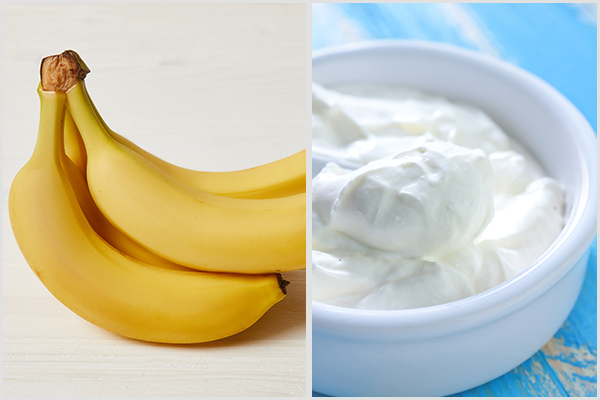
2. A probiotic dose of greek yogurt
Greek yogurt is another cheap food that can fit any budget. It contains several nutrients that support good health. It is packed with much higher protein than regular yogurt and is also a good source of calcium and vitamin D.
Another health advantage comes in the form of improved digestive health as yogurt is well endowed with gut-friendly bacteria, making it a probiotic that you just cannot overlook.
A 2017 study published in Critical Reviews in Food Science and Nutrition lends further credence to the effectiveness of yogurt intake for improving gut health. The study further suggests that consumption of yogurt reduces chronic inflammation by enhancing innate and adaptive immune responses, intestinal barrier function, and lipid profiles and by regulating appetite. (5)
It is even good for brain health. In a 2013 study published in Gastroenterology, researchers reported that women who consumed probiotic yogurt displayed a higher degree of cognitive responsiveness in their brains than those who consumed nonfermented yogurt or no yogurt at all. (6)
Yogurt not only positively influences your gut and brain health, but it also reduces the risk of type 2 diabetes, which was corroborated by a 2014 study published in BMC Medicine. The study reports that a higher intake of yogurt is associated with a reduced risk of type 2 diabetes, whereas other dairy foods and total dairy consumption are not appreciably associated with the incidence of type 2 diabetes. (7)
You can eat Greek yogurt topped with some fruit as a healthy breakfast or use it to make a filling smoothie. You can even use it to make marinades, dressings, and dips, and you can use it in place of heavy cream, mayonnaise, or sour cream in various recipes.
3. Say yes to oats
Oats are cereal grains that can provide plenty of nutrients without making much of a hole in your pocket. Being high in fiber and protein but low in fat, eating oats daily is a sure and safe way to lower cholesterol.
Plus, the beta-glucan compounds in oats slow the rate at which carbohydrates are absorbed by the body. This is why they help people feel full for a longer time.
A study published in the Journal of the American College of Nutrition reports that oatmeal improves appetite control and increases satiety. The effects may be attributed to the viscosity and hydration properties of its beta-glucan content. (8)
Oats are also a good source of thiamin, magnesium, phosphorus, and manganese.
Eating whole grains such as oats is associated with up to 15% lower mortality, particularly cardiovascular disease-related mortality, according to a 2015 study published in JAMA Internal Medicine. (9)
Trust a healthy bowl of breakfast oatmeal to give you the energy you need for tackling the days that lay ahead. You can soak oats in milk or some fruit juice overnight for a quick breakfast fix in the morning.
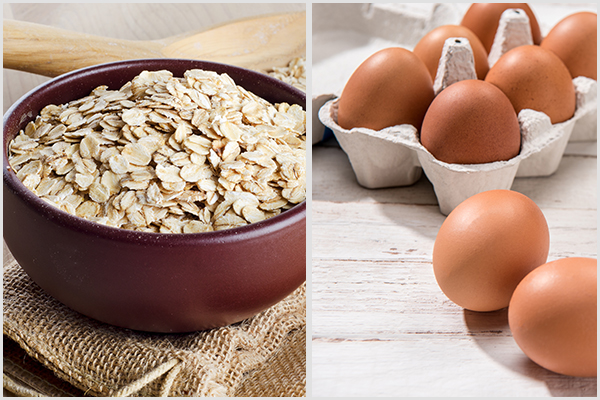
4. The nutritious delight of eggs
Eggs are one of the most nutritious foods you can eat, even if your budget is tight. They are one of the few foods that contain all nine essential amino acids and are also rich in iron, phosphorous, selenium, and vitamins A, B12, B2, and B5.
Not just that, eggs are also particularly rich in choline. A study published in Nutrition Reviews expounded the health merits of choline, which is an essential nutrient that plays a key role in metabolism, from cell structure to neurotransmitter synthesis. (10)
Conversely, choline deficiency has been found to be associated with diseases such as liver disease, atherosclerosis, and, possibly, neurological disorders.
According to the American Optometric Association, eggs are a good source of two carotenoids, lutein, and zeaxanthin, that reduce the risk of chronic eye diseases, including age-related macular degeneration (AMD) and cataracts. (11)
Hard-boiled eggs or an omelet makes a great breakfast food. You can even incorporate eggs into your dinner meals in the form of scrambled eggs with some crunchy vegetables.
5. Leafy green spinach will help
This dark green leafy vegetable is another cost-effective food that you can buy by shelling only a few bucks.
Spinach is loaded with nutrients, including calcium and potassium, and is high in vitamins, including vitamin A and K. While vitamin A is needed for healthy skin and hair, vitamin K ensures strong bones. Plus, the high fiber and water content in spinach are good for your digestive system.
Other nutrients in it are iron, magnesium, manganese, phosphorus, zinc, selenium, copper, and nitrates. Being low in calories, spinach is simply excellent for people seeking to lose weight.
A study published in Cell Metabolism reports that spinach supports muscle health. The nitrates in it make the mitochondria of cells function more efficiently, which is important for muscle health. (12)
The nitric oxide in it opens up the blood vessels to lower blood pressure. Additionally, the carotenoids lutein and zeaxanthin in spinach may help remove free radicals from the body and protect your vision from age-related problems.
A glass of spinach juice with a tinge of lemon juice can provide a great start to your day. You can also add spinach to salads or add some into your morning smoothie for complementary health benefits. It can also be cooked lightly and eaten as a side dish.
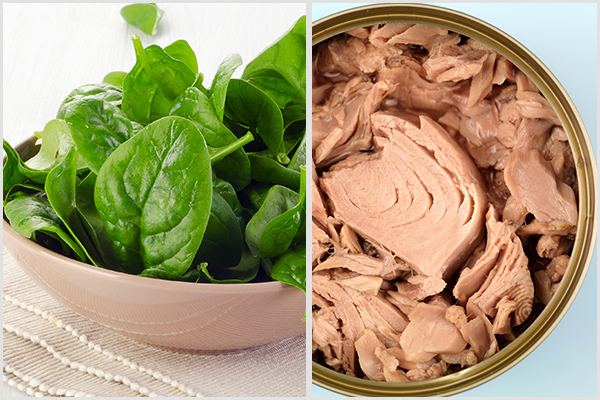
6. Canned tuna will save you the trouble
Seafood often figures among the sought-after and relatively luxurious culinary categories. If you happen to be a fan, there is no need to deny yourself the pleasure of seafood even during a financial slump. Indulge your taste buds by devouring canned tuna from time to time, which is both inexpensive and scrumptiously healthy, too.
Canned tuna is a rich source of omega-3 fatty acids, the healthy unsaturated fats that play a key role in improving blood vessel functioning, lowering blood pressure, and reducing the risk of cardiovascular disease. Omega-3 fatty acids also support a healthy brain and promote proper growth and development.
One of the B vitamins found in canned tuna is niacin, which prevents bad cholesterol from being stored as plaque inside artery walls. It is also a good source of lean protein, which is needed for cell growth and a healthy immune system and for maintaining muscle tissue.
Tuna also contains calcium, iron, selenium, magnesium, and potassium.
For a quick, easy lunch, simply add canned tuna fish to a salad and dress it with a little olive oil and lemon juice. Another option is to mix tuna with hummus or Greek yogurt for a healthy tuna salad.
Note: Due to its mercury content, pregnant women should limit their consumption of tuna to no more than 6 ounces per week.
7. Thumbs-up to sweet potatoes
Sweet potatoes are an excellent choice for a low-cost side dish for lunch or dinner. Sweet potatoes contain a good amount of your daily recommended value of vitamins A and C. They are also rich in calcium, potassium, and iron.
Furthermore, the antioxidants in them help ward off cancer and protect against the effects of aging. Being high in carotenoids such as beta-carotene, which is the precursor to vitamin A in your body, sweet potatoes also are good for your vision and protect your skin from sun damage.
A 2011 study published in the Journal of Medicinal Food reports that purple sweet potato extract has antilipogenic, anti-inflammatory, and lipolytic effects on adipocytes and has free-radical scavenging and reducing activity. (13)
Another 2014 study published in the same journal further highlights the merits of sweet potato as a valuable medicinal food owing to its high nutritional value. It is also a valuable medicinal plant having anticancer, antidiabetic, and anti-inflammatory activities. (14)
Enjoy sautéed, baked, steamed, or fried sweet potatoes for a filling and tasty lunch or dinner side dish. You can even add sweet potatoes to your soups or salads.
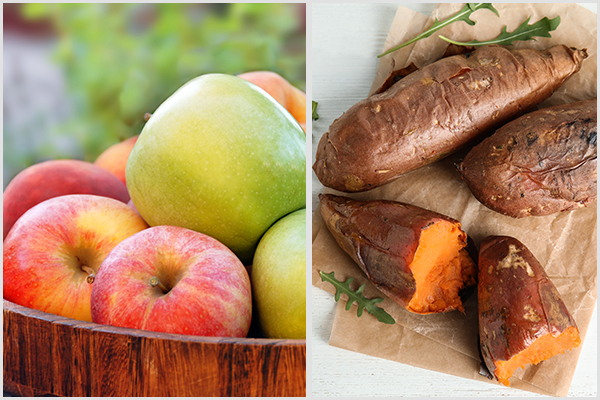
8. Partake apples
An apple a day keeps the doctor away! This rings particularly true for people in a financial fix.
Apples are extremely rich in important antioxidants, flavonoids, and dietary fiber. Being low in sugar and high in soluble fiber, apples help fill you up quickly and stabilize your blood sugar levels. (15)
Eating 1 to 2 apples a day is linked to a decreased risk of cancer, diabetes, and even asthma.
Apart from fiber, apples also contain many other important nutrients including vitamin C (a powerful natural antioxidant), B-complex vitamins (riboflavin, thiamin, and vitamin B6), phytonutrients, calcium, potassium, and phosphorus. They are also low in calories and contain no fat or cholesterol. (16)
As most of the nutrients are present just under the skin, it is a good idea to eat organic apples with their skins.
Apples can be eaten as a whole fruit for a healthy mid-morning or mid-afternoon snack. They are also great in juices and smoothies, and they’re deliciously sliced into salads.
9. Spill the beans in your diet
Just a ½ cup of beans provides as much protein as an ounce of meat, without the saturated fat. Plus, the fact that they are much cheaper than meat only further endears them to those running low on cash.
Beans are also packed with fiber as well as iron, magnesium, potassium, and folate. The fiber in them helps promote satiety and keeps your appetite in check. Thus, you end up reducing your overall dietary expenditure throughout the day.
Another good aspect of beans is that they contain little to no fat and are cholesterol-free. This means this plant-based protein actually helps lower cholesterol and triglyceride levels instead of potentially causing them to increase like many other food sources of protein.
A 2014 study published in the American Journal of Clinical Nutrition reports that beans are excellent sources of protein and a number of micronutrients, which may account for some of their proposed health benefits. The study emphasizes making efforts to encourage more bean consumption. (17)
Depending upon your cooking skill and convenience level, you can opt for dried beans or canned beans. While canned beans can be added to salads, dried beans can be boiled and used to make burgers, soups, and stews.
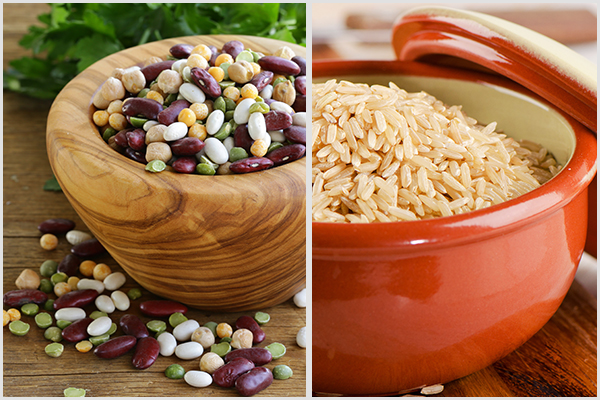
10. Switch to brown rice
Another whole grain that can snug within your economical budget is brown rice. This fibrous component helps add texture and satiety to your meals, making them even more dynamic and fulfilling. The high fiber content in brown rice is good for digestive health and helps keep you feeling full longer.
Moreover, a study published in the Harvard School of Public Health found that eating two or more servings of brown rice per week was associated with a lower risk of diabetes. (18) Brown rice also contains manganese, which helps synthesize body fats and keep your weight under control.
A 2012 study published in Bioscience, Biotechnology, and Biochemistry report that germinated brown rice suppresses weight gain, lipid accumulation in the liver, and epididymal adipocytes and improves serum lipid profiles. This makes germinated brown rice a potential agent against obesity. (19)
These unrefined whole grains are also known to reduce the buildup of arterial plaque and reduce the risk of heart disease and high cholesterol. Plus, the selenium in them reduces the risk of developing common illnesses, such as cancer, heart disease, and arthritis. (20)(21)
Cook brown rice and serve it as an easy side dish for well-balanced meals.
Final Word
In order to rein in their expenditure, a lot of people resort to health-and diet-related budget cuts that can be counterintuitive in the grand scheme of things. Compromising on your nutrition can pave the way for illness.
And when you consider the exorbitant medical costs that come with treating even the most common ailment, your reluctance to spend on food would seem rather short-sighted. The wise thing to do is to look for healthy but affordable foods that give you maximum nutrition at minimum cost.
- Was this article helpful?
- YES, THANKS!NOT REALLY


